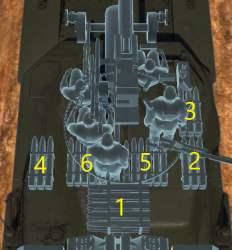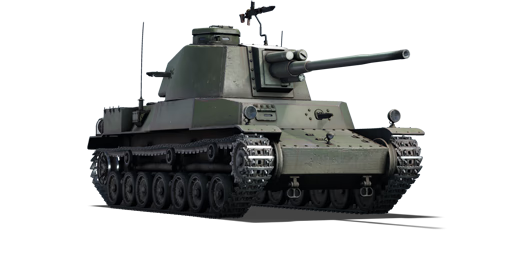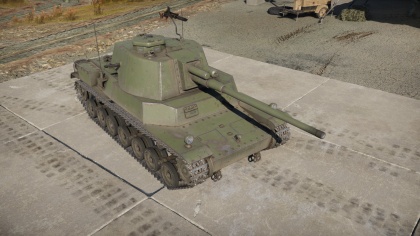Difference between revisions of "Chi-To"
m (Grammar fix.) (Tag: Visual edit) |
(→Main armament) (Tag: Visual edit) |
||
| Line 71: | Line 71: | ||
! style="width:4em" |Prior + Ace qualif. | ! style="width:4em" |Prior + Ace qualif. | ||
|- | |- | ||
| − | | ''Arcade'' || 7.6 || 10.5 || | + | | ''Arcade'' || 7.6 || 10.5 || 20.32 || 22.5 || 23.91 |
|- | |- | ||
| − | | ''Realistic'' || 7.6 || 8.9 || | + | | ''Realistic'' || 7.6 || 8.9 || 10.76 || 11.9 || 12.7 |
|- | |- | ||
! colspan="4" | Reloading rate (seconds) | ! colspan="4" | Reloading rate (seconds) | ||
| Line 82: | Line 82: | ||
! colspan="1" style="width:4em" |Prior + Ace qualif. | ! colspan="1" style="width:4em" |Prior + Ace qualif. | ||
|- | |- | ||
| − | | 10. | + | | 10.01 || 8.86 || 8.16 || 7.7 |
|- | |- | ||
|} | |} | ||
Revision as of 04:18, 15 June 2020
Contents
| This page is about the medium tank Chi-To. For the late version, see Chi-To Late |
Description
The Type 4 Chi-To is a Rank III Japanese medium tank
with a battle rating of 4.7 (AB/RB/SB). It was introduced along with the initial Japanese Ground Forces tree in Update 1.65 "Way of the Samurai".
The Type 4 Chi-To looks similar to the Type 3 Chi-Nu, though with a longer chassis with an extra wheel. Turret is also similar in look, though the turret side is more smooth and has a machine gun sticking out the right side. The big differences on the turret is the gun barrel. The gun barrel has no muzzle brake in its design and the recoil tube has been moved from a single tube on the bottom to two tubes on top.
Playing the Type 4 Chi-To can give the player a new impression of the Japanese tree line and a lasting one considering many of the Japanese tanks after it follow the same pattern. A tank with a very powerful cannon, decent mobility, but rather terrible armour. The terrible armour plus the tank's rather long reload means that the Chi-To is meant more for a long-distance shoot out than a close encounter.
General info
Survivability and armour
Armour type:
- Rolled homogeneous armour
- Cast homogeneous armour (Gun mantlet, Machine gun port)
| Armour | Front | Sides | Rear | Roof |
|---|---|---|---|---|
| Hull | 75 mm (17°) Front plate 20 mm (76°) Front glacis 75 mm (16°), 20 mm (58°) Lower glacis 50 mm (12°) Front cheeks 50 mm (0-66°) Machine gun port |
35 mm (12-30°) Top 35 mm Bottom |
20 mm (73°) Top 35 mm Center 20 mm (48°) Bottom |
20 mm |
| Turret | 75 mm (16°) Turret front 50-75 mm (10°) Gun mantlet |
50 mm (15-16°) 50 mm (0-65°) Right machine gun port |
50 mm (15-50°) Turret rear 10 mm Turret rear underside |
20 mm |
| Armour | Sides | Roof | ||
| Cupola | 75 mm | 20 mm |
Notes:
- Suspension wheels are 15 mm thick while tracks are 20 mm thick.
- 10 mm RHA plates are scattered on the lower side hull.
- Turret ring is 20 mm thick.
Mobility
| Game Mode | Max Speed (km/h) | Weight (tons) | Engine power (horsepower) | Power-to-weight ratio (hp/ton) | |||
|---|---|---|---|---|---|---|---|
| Forward | Reverse | Stock | Upgraded | Stock | Upgraded | ||
| Arcade | 50 | 10 | 30.5 | 620 | 954 | 20.33 | 31.28 |
| Realistic | 45 | 9 | 354 | 500 | 11.61 | 16.39 | |
Armaments
Main armament
| 75 mm Type II Model II | |||||
|---|---|---|---|---|---|
| Capacity | Vertical guidance |
Horizontal guidance |
Stabilizer | ||
| 55 | -10°/+20° | ±180° | N/A | ||
| Turret rotation speed (°/s) | |||||
| Mode | Stock | Upgraded | Prior + Full crew | Prior + Expert qualif. | Prior + Ace qualif. |
| Arcade | 7.6 | 10.5 | 20.32 | 22.5 | 23.91 |
| Realistic | 7.6 | 8.9 | 10.76 | 11.9 | 12.7 |
| Reloading rate (seconds) | |||||
| Stock | Prior + Full crew | Prior + Expert qualif. | Prior + Ace qualif. | ||
| 10.01 | 8.86 | 8.16 | 7.7 | ||
Ammunition
| Penetration statistics | |||||||
|---|---|---|---|---|---|---|---|
| Ammunition | Type of warhead |
Penetration in mm @ 90° | |||||
| 10m | 100m | 500m | 1000m | 1500m | 2000m | ||
| Type 1 APHE | APHE | 137 | 133 | 120 | 102 | 89 | 78 |
| Type 4 Kou | APHE | 157 | 155 | 142 | 124 | 111 | 105 |
| Type 90 HE | HE | 8 | 8 | 8 | 8 | 8 | 8 |
| Shell details | ||||||||||
|---|---|---|---|---|---|---|---|---|---|---|
| Ammunition | Type of warhead |
Velocity in m/s |
Projectile Mass in kg |
Fuse delay
in m: |
Fuse sensitivity
in mm: |
Explosive Mass in g (TNT equivalent): |
Normalization At 30° from horizontal: |
Ricochet: | ||
| 0% | 50% | 100% | ||||||||
| Type 1 APHE | APHE | 865 | 6.6 | 1.3 | 15 | 67.84 | ° | 47° | 60° | 65° |
| Type 4 Kou | APHE | 865 | 6.8 | 1.3 | 15 | 80.64 | ° | 47° | 60° | 65° |
| Type 90 HE | HE | 830 | 6.2 | 0.1 | 0.1 | 490 | +0° | 79° | 80° | 18° |
Ammo racks

| Full ammo |
1st rack empty |
2nd rack empty |
3rd rack empty |
4th rack empty |
5th rack empty |
6th rack empty |
7th rack empty |
Recommendations | Visual discrepancy |
|---|---|---|---|---|---|---|---|---|---|
| 55 | 45 (+10) | 40 (+15) | 34 (+21) | 28 (+27) | 28 (+27) | 14 (+41) | 1 (+54) | No |
Turret empty: 40 (+15)
Machine guns
| 7.7 mm Type 97 | ||||||
|---|---|---|---|---|---|---|
| Pintle mount | ||||||
| Capacity (Belt capacity) | Fire rate (shots/minute) |
Vertical guidance |
Horizontal guidance | |||
| 1,000 (20) | 499 | -10°/+70° | ±60° | |||
| Hull mount | ||||||
| Capacity (Belt capacity) | Fire rate (shots/minute) |
Vertical guidance |
Horizontal guidance | |||
| 3,000 (20) | 499 | ±8° | ±8° | |||
Usage in the battles
Against the medium tanks, its simply getting the first shot off first as the 75 mm Type 5 cannon on the Chi-To could penetrate most through the front hull armour, with some levels of difficulty on the turret. Of course, for maximizing the Chi-To's own survival, attack from the sides and make sure the enemy is unaware of the Chi-To's presence.
Against the heavies is a more complicated method due to their armour becoming near impervious to the Chi-To if angled. Thus, it is best to go for the side armour if possible to deal the most damage possible. Though, the only tank most invincible to the Chi-To's armament from the front is the British Churchill Mk VII and maybe the American M4A3E2 Jumbo, so beware if caught in a frontal engagement.
Modules
| Tier | Mobility | Protection | Firepower | ||
|---|---|---|---|---|---|
| I | Tracks | Parts | Horizontal Drive | ||
| II | Suspension | Brake System | FPE | Adjustment of Fire | Type 4 Kou |
| III | Filters | Crew Replenishment | Elevation Mechanism | ||
| IV | Transmission | Engine | Artillery Support | ||
Pros and cons
Pros:
- Powerful 75 mm cannon rivaling the T-34-85's, good penetration and very low shell drop-off.
- APHE round can easily defeat enemy tanks.
- A very powerful tank at 4.3, can tackle all foes at its BR bracket.
- Decent gun depression of -11°
- Ammo in the turret can be emptied by carrying 15 less ammo.
- Very powerful Type 4 Kou shell with more penetration and more explosive filler.
- Decent top armour, enough to resist strafing aircraft weapons.
Cons:
- Armour is average and mostly flat and unangled, like the Panzer IV.
- The Chi-To is asymmetric and is a large tank, it is difficult to hide from enemies.
- Reload rate quite slow.
- Angling front armour can expose the 50 mm hull cheek armour.
- Very hard to turn on the spot, especially when stock.
History
Development
The lackluster performance of Japanese tanks in World War II called for the development of newer medium tanks in the Imperial Japanese Army. The standard tank of the time was the Type 97 Chi-Ha, which has its chassis used in many expedient models to provide a bigger gun for the Japanese inventory such as the Chi-Ha Kai, Type 1 Chi-He, Type 2 Ho-I, and Type 3 Chi-Nu. By the time of Chi-Nu, however, the Chi-Ha chassis was becoming outdated and so a new tank design using an improved chassis was needed for future development.[1]
In 1943, development started of the Chi-To tank, which features a new chassis and more powerful engine. Its armament is a 75 mm gun based off the Type 88 anti-aircraft gun, giving it a high-velocity weapon. Armour on the tank was welded and was quite thick in comparison to its predecessor at 75 mm thick. The tank was accepted for service in 1944 and was expected to enter mass production with 20 per month at Mitsubishi and 5 per month at Kobe-Seiko. In terms of Japanese armour development, the Chi-To was the most sophisticated tank to enter production levels.[1]
War's End
Despite its potential, the Type 4 Chi-To was never made in large numbers. At the war's end, only six chassis were made, with only two of those made into tanks.
The two Type 4 produced were cast into Lake Hamana between the 23 and the 28 August 1945 to avoid their capture. One was found by the U.S. occupation forces following Japan's surrender in World War II. The tank was then transported to Aberdeen Proving Grounds for tests and would eventually scrap them in October 1952.[2]
The second tank is still believed to be at the bottom of the lake. A project to find it was launched in 2013 by SM@Pe, a group of people from Hamamatsu. Inhabitants, volunteers, divers and the Windy Network Corp ( a marine studies company from Tôkyô who founded a trainning plane of the Japanese imperial army in the lake Towada in 2010) participated to research, supported by the use of a sonar and testimonials, including former soldiers who allegedly participated in the launching operation. The research did not give anything.
Media
An excellent addition to the article will be video guides, as well as screenshots from the game and photos.
References
Read also
Links to the articles on the War Thunder Wiki that you think will be useful for the reader, for example,
- reference to the series of the vehicles;
- links to approximate analogues of other nations and research trees.
ETC.
Sources
- Zaloga Steven. Japanese Tanks 1939-1945 Great Britain: Osprey Publishing Ltd., 2007
- Sun, Eun Ae. Chi-Ri & Chi-To: Aberdeen Tank Scrapping. YouTube, YouTube, 7 Aug. 2017, Video
| Japan medium tanks | |
|---|---|
| Type 97 | Chi-Ha · Chi-Ha Kai · Chi-Ha Kai TD · Chi-Ha Short Gun |
| Type 1 | Chi-He · Chi-He (5th Regiment) · Ho-I |
| Type 3 | Chi-Nu · Chi-Nu II |
| Type 4 | Chi-To · Chi-To Late |
| Type 5 | Chi-Ri II |
| Type 61 MBT | ST-A1* · ST-A2* · ST-A3* · Type 61 |
| Type 74 MBT | ST-B2* · Type 74 (C) · Type 74 (E) · Type 74 (F) · Type 74 (G) |
| Type 90 MBT | Type 90 · Type 90 (B) · Type 90 (B) "Fuji" |
| Type 10 MBT | TKX (P)* · TKX* · Type 10 |
| Other | Ka-Chi |
| USA | ▅M4A3 (76) W · ▅M47 |
| *Prototype | |





